Related Research Articles

Camelot is a legendary castle and court associated with King Arthur. Absent in the early Arthurian material, Camelot first appeared in 12th-century French romances and, since the Lancelot-Grail cycle, eventually came to be described as the fantastic capital of Arthur's realm and a symbol of the Arthurian world.

The Knights of the Round Table are the legendary knights of the fellowship of King Arthur that first appeared in the Matter of Britain literature in the mid-12th century. The Knights are an order dedicated to ensuring the peace of Arthur's kingdom following an early warring period, entrusted in later years to undergo a mystical quest for the Holy Grail. The Round Table at which they meet is a symbol of the equality of its members, who range from sovereign royals to minor nobles.

Percival, alternatively called Peredur, is a figure in the legend of King Arthur, often appearing as one of the Knights of the Round Table. First mentioned by the French author Chrétien de Troyes in the tale Perceval, the Story of the Grail, he is best known for being the original hero in the quest for the Grail, before being replaced in later literature by Galahad.
Rustichello da Pisa, also known as Rusticiano, was an Italian romance writer in Franco-Italian language. He is best known for co-writing Marco Polo's autobiography, The Travels of Marco Polo, while they were in prison together in Genoa. Earlier, he wrote the Roman de Roi Artus, also known as the Compilation, the earliest known Arthurian romance by an Italian author.

Gaheris is a Knight of the Round Table in the chivalric romance tradition of Arthurian legend. A nephew of King Arthur, Gaheris is the third son of Arthur's sister or half-sister Morgause and her husband Lot, King of Orkney and Lothian. He is the younger brother of Gawain and Agravain, the older brother of Gareth, and half-brother of Mordred. His figure may have been originally derived from that of a brother of Gawain in the early Welsh tradition, and then later split into a separate character of another brother, today best known as Gareth. German poetry also described him as Gawain's cousin instead of brother.
Robert de Boron was a French poet active around the late 12th and early 13th centuries, notable as the reputed author of the poems Joseph d'Arimathie and Merlin. Although little is known of Robert apart from the poems he allegedly wrote, these works and subsequent prose redactions of them had a strong influence on later incarnations of the Arthurian legend and its prose cycles, in particular through their Christianisation and redefinition of the previously ambiguous Grail motif and the character of Merlin, as well as vastly increasing the prominence of the latter.
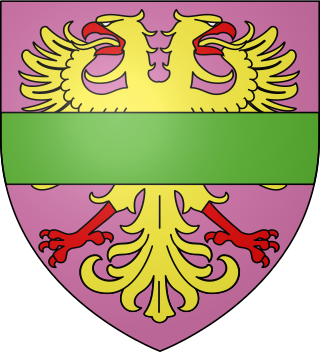
Sir Agravain is a Knight of the Round Table in Arthurian legend, whose first known appearance is in the works of Chrétien de Troyes. He is the second eldest son of King Lot of Orkney with one of King Arthur's sisters known as Anna or Morgause, thus nephew of King Arthur, and brother to Sir Gawain, Gaheris, and Gareth, as well as half-brother to Mordred. Agravain secretly makes attempts on the life of his hated brother Gaheris since the Vulgate Cycle, participates in the slayings of Lamorak and Palamedes in the Post-Vulgate Cycle, and murders Dinadan in the Prose Tristan. In the French prose cycle tradition included in Thomas Malory's Le Morte d'Arthur, together with Mordred, he then plays a leading role by exposing his aunt Guinevere's affair with Lancelot, which leads to his death at Lancelot's hand.
Sir Dagonet is a Knight of the Round Table in Arthurian legend. His depictions and characterisations variously portray a foolish and cowardly knight, a violently deranged madman, to the now-iconic image of King Arthur's beloved court jester.
This is a bibliography of works about King Arthur, his family, his friends or his enemies. This bibliography includes works that are notable or are by notable authors.
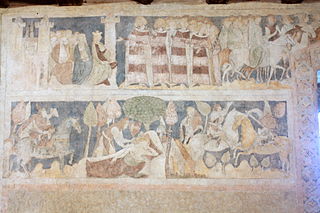
The Lancelot-Grail Cycle, also known as the Vulgate Cycle or the Pseudo-Map Cycle, is an early 13th-century French Arthurian literary cycle consisting of interconnected prose episodes of chivalric romance originally written in Old French. The work of unknown authorship, presenting itself as a chronicle of actual events, retells the legend of King Arthur by focusing on the love affair between Lancelot and Guinevere as well as the religious quest for the Holy Grail. The highly influential cycle expands on Robert de Boron's "Little Grail Cycle" and the works of Chrétien de Troyes, previously unrelated to each other, by supplementing them with additional details and side stories, as well as lengthy continuations, while tying the entire narrative together into a coherent single tale. Its alternate titles include Philippe Walter's 21st-century edition Le Livre du Graal.
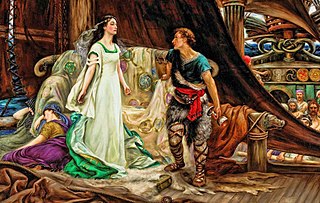
Tristan and Iseult, also known as Tristan and Isolde and other names, is a medieval chivalric romance told in numerous variations since the 12th century. Based on a Celtic legend and possibly other sources, the tale is a tragedy about the illicit love between the Cornish knight Tristan and the Irish princess Iseult. It depicts Tristan's mission to escort Iseult from Ireland to marry his uncle, King Mark of Cornwall. On the journey, Tristan and Iseult ingest a love potion, instigating a forbidden love affair between them.
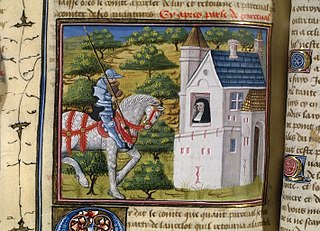
Perceval, the Story of the Grail is the unfinished fifth verse romance by Chrétien de Troyes, written by him in Old French in the late 12th century. Later authors added 54,000 more lines to the original 9,000 in what are known collectively as the Four Continuations, as well as other related texts. Perceval is the earliest recorded account of what was to become the Quest for the Holy Grail but describes only a golden grail in the central scene, does not call it "holy" and treats a lance, appearing at the same time, as equally significant. Besides the eponymous tale of the grail and the young knight Perceval, the poem and its continuations also tell of the adventures of Gawain and some other knights of King Arthur.
Cligès is a poem by the medieval French poet Chrétien de Troyes, dating from around 1176. It is the second of his five Arthurian romances; Erec and Enide, Cligès, Yvain, Lancelot and Perceval. The poem tells the story of the knight Cligès and his love for his uncle's wife, Fenice.

The Post-Vulgate Cycle, also known as the Post-Vulgate Arthuriad, the Post-Vulgate Roman du Graal or the Pseudo-Robert de Boron Cycle, is one of the major Old French prose cycles of Arthurian literature from the early 13th century. It is considered essentially a rewriting of the earlier and more popular Vulgate Cycle, with much left out but also much added, including characters and scenes from the Prose Tristan. The cycle has not survived in any manuscript in its entirety and has been reconstructed from fragments in various languages.
Meliodas is a figure in Arthurian legend in the 12th-century Prose Tristan and subsequent accounts. In Thomas Malory's Le Morte d'Arthur, he is the second king of Lyonesse, son of Felec of Cornwall and vassal of King Mark. Meliodas' first wife, Elizabeth, who bore the hero Tristan, was Mark's sister, and his second wife was a daughter or sister of Hoel of Brittany. He is the eponymous protagonist of the romance Meliadus. The Italian variant Tristano Riccardiano calls him Felix (Felissi).
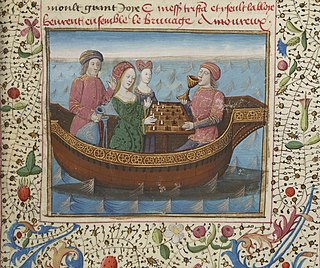
The Prose Tristan is an adaptation of the Tristan and Iseult story into a long prose romance, and the first to tie the subject entirely into the arc of the Arthurian legend. It was also the first major Arthurian prose cycle commenced after the widely popular Lancelot-Grail, which influenced especially the later portions of the Prose Tristan.

Brunor, Breunor, Branor or Brunoro are various forms of a name given to several different characters in the works of the Tristan tradition of Arthurian legend. They include Knight of the Round Table known as Brunor/Breunor le Noir, as well as his father and others, among them another former knight of Uther's old Round Table and the father of Galehaut.
Perlesvaus, also called Li Hauz Livres du Graal, is an Old French Arthurian romance dating to the first decade of the 13th century. It purports to be a continuation of Chrétien de Troyes' unfinished Perceval, the Story of the Grail, but it has been called the least canonical Arthurian tale because of its striking differences from other versions.
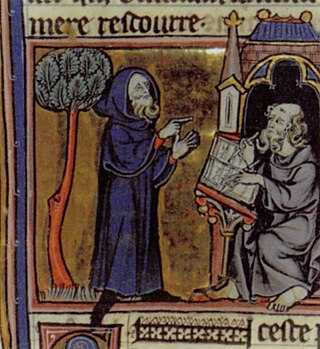
Merlin is a partly lost French epic poem written by Robert de Boron in Old French and dating from either the end of the 12th or beginning of the 13th century. The author reworked Geoffrey of Monmouth's material on the legendary Merlin, emphasising Merlin's power to prophesy and linking him to the Holy Grail. The poem tells of his origin and early life as a redeemed Antichrist, his role in the birth of Arthur, and how Arthur became King of Britain. Merlin's story relates to Robert's two other reputed Grail poems, Joseph d'Arimathie and Perceval. Its motifs became popular in medieval and later Arthuriana, notably the introduction of the sword in the stone, the redefinition of the Grail, and turning the previously peripheral Merlin into a key character in the legend of King Arthur.
Guiron le Courtois is a character in Arthurian legend, a knight-errant and one of the central figures in the French romance known as Palamedes, with later versions named Guiron le Courtois and the Compilation of Rustichello da Pisa. In the course of his adventures he becomes the companion of Danyn the Red, Lord of the Castle of Malaonc, whose wife, the Lady of Malaonc, is the most beautiful woman in Britain. Guiron and the lady fall in love, but the courteous knight remains loyal to his friend Danyn. Later both knights fall in love with the lady Bloye, but this time Guiron triumphs, though the couple are imprisoned and the story continues with the adventures of their son, also named Guiron.
References
- 1 2 3 4 5 Lacy, Norris J. (1991), "Palamedes", in Lacy, Norris J. (ed.), The New Arthurian Encyclopedia, New York: Garland, p. 352
- 1 2 Bogdanow 1966, p. 46.
- 1 2 3 Hoffman, Donald L. (1991), "Rusticiano da Pisa", in Lacy, Norris J. (ed.), The New Arthurian Encyclopedia, New York: Garland, p. 392
- ↑ For a detailed analysis of printed versions and their relationships to extant manuscripts, see Lathuillère 1966, pp. 159-64